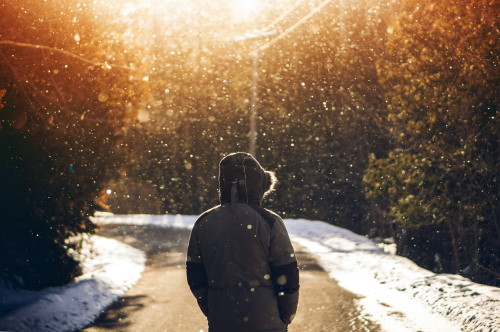In the winter months, many of us shelter inside for work and play. And as the weather chills and the days get shorter, we find almost every hour illuminated by artificial light. The only breath of fresh air we may experience is rushing from the front door to the car and from the car to the office, gym, or store. No wonder alarm bells are beginning to ring about a new increasingly troubling issue: Nature Deficit Disorder.
While Nature Deficit Disorder may not be recognized as a medical condition (yet), there’s no doubt it has negative consequences for our mental and physical health. And even if we do get outside for a few minutes, there’s often so much competing for our attention that we may miss out on the amazing natural wonders every moment.
BREAKING: Viagra Obsolete: New Invention Cheaper, Safer, Faster
For instance, when eyeballs are glued to a small screen or we’re engrossed in a podcast or playlist, we can miss wildlife activity, even if it’s just small creatures like birds, squirrels, rabbits, raccoons, or foxes. Indeed, you don’t necessarily need to walk through the woods to see abundant wildlife. Many critters are quite comfortable in urban environments and can help us connect with nature up close. Trees, grasses, and gardens also provide vital and healing connections to the natural world.
Where Does the Phrase Nature Deficit Disorder Come From?
The phrase Nature Deficit Disorder was coined by Richard Louv in his book Last Child in the Woods, published in 2005. In the book, he explains his observation that all of us—especially kids—are spending less and less time outdoors and more time attached to artificial devices in artificial environments. Open spaces are disappearing to make way for more roads and housing as more people live in urban areas and cities sprawl.
This alienation is cutting us off from the natural world around us and increases the likelihood of more depressed moods and reduced attention spans. This disconnection from nature can also negatively affect our health due to increased traffic and pollution. It’s also been found to diminish the use of our senses and increase the risk of obesity and other physical and emotional conditions as we become less active.
At times, we may even lose the desire and knowledge to care for the land and environment around us. And for children, it has resulted in not only inactivity but the devaluation of independent play most adults remember so fondly and that helped us grow and learn. This lack of play in nature has also negatively affected mental health and cognitive functioning. Research has even discovered children who spend less time outdoors are much more likely to become nearsighted.
What’s more, having access to green space has been found to reduce heart rate and violence and even decrease the risk of early death.
An Outdoor Prescription
Fortunately, inviting nature back into everyday life is not difficult, and it’s becoming more popular. For example, experts like Tim Skwiat and Andrew Huberman recommend spending 5 to 30 minutes every morning outside in the sunlight (within 30 to 60 minutes of waking) to reset or better support your circadian rhythm, stay energized during the day, and promote optimal sleep. Huberman also recommends getting outdoors in the afternoon for the red and orange, lower frequency light, which again encourages more restful sleep.
Because of the positive shift in cortisol levels, time spent outside can also help improve energy and mood, boost healthy immune functioning, and help decrease the effects of stress.
Even with minimal outdoor space, you can create a green environment that attracts wildlife, including bees and butterflies. A small container garden can help expand your knowledge of nature as well as boost your mental health and give you more reasons to breathe fresh air.
Public parks, fields, and botanic gardens are great places to walk, run, play, and explore to reconnect with the natural world. Basically, any interaction with nature or venture into some type of outdoor space provides benefits. You can benefit from watching a cricket chirping or a bird or butterfly flying from your front porch, patio, or courtyard, or venture out to climb a mountain, stroll through a forest, or swim in the sea.
We are, however, entering the winter months in many parts of the world. And adults, as well as children, often stay inside even more when it’s cold.
There’s No Such Thing as Bad Weather
Scandinavians have a saying: “There’s no such thing as bad weather, only bad clothing.” During the winter months, countries in this region of the world get frosty and seriously cold. You may think that means people head indoors and stay there until it starts to thaw. In fact, temperatures dropping below freezing unlocks an abundance of fun outdoor activities for young and old in these Nordic countries. Enjoying the long, cold winters isn’t about staying inside but rather about being well-prepared to face the elements.
When facing similar weather, to stay warm and dry, you’ll want to strategically layer your clothing to balance moisture-wicking, breathability, and warmth. The right clothing options can turn even the most frigid outing into an awe-inspiring adventure.
Start with a soft, warm, moisture-wicking base layer close to the skin. This layer helps wick away sweat to keep you dry and thus warmer. Merino wool is one of the best options. You can also find more high-tech base layers made with synthetic fabrics. Avoid cotton, though, as it naturally retains moisture, which can cause discomfort and make you feel colder, especially if you work up a sweat.
Add another insulating layer next to keep your body heat in. Fleece, down, and synthetic fills are popular choices. Choose a thicker layer for really cold days or thinner layers if conditions are tamer.
The last or outer layer will keep out the wind and water if necessary. Choose a hard- or softshell jacket that’s breathable and allows you to cool down quickly if it gets warm by offering ventilation such as pit zips if you plan to be active.
The best outdoor cold-weather gear is easily adjustable as your body warms or the weather changes. You’ll also want gear that fits well together. For example, you’ll want an outer shell large enough to fit over a thicker insulating layer. You’ll also want layers that are easy to shed to avoid overheating.
Finally, don’t forget to cover your head with a hat and scarf or neck gaiter, and keep the fingers protected with quality gloves that keep your digits dry. You can also protect your face with a face mask and sunglasses or goggles to protect your eyes from bright sun and wind.
All Dressed Up and Everywhere to Go
Now that you have your gear, you can choose your outdoor adventure—from forest bathing in a winter wonderland to an invigorating hike or snowshoeing in a nearby outdoor space. You can also choose skiing—downhill or cross-country. Or relive your childhood by grabbing some ice skates, a sled, or a snow tube (and maybe a to-go thermos filled with hot chocolate) for some serious outdoor fun. Bringing your kids, grandkids, nieces, or nephews along can be even more fun.
If you go as a group, you can enjoy your own winter games, such as a classic snowball fight, ice bowling, building a snowman, or a scavenger hunt.
Or, you can enjoy your usual fitness activities, such as walking, hiking, running, or even cycling as long as your bike has studded tires for traction.
And if it’s just a bit chilly but there’s no snow blanketing the ground, you can play tag, kickball, frisbee, frisbee golf, etc., which can be even more invigorating as the weather cools. Or enjoy a nature hike, go bird watching, or set yourself up to stargaze.
Safety First
Especially if you’re new to outdoor adventures (though these are good reminders for all of us) and it’s cold or snowy, take a few precautions to stay safe:
TRENDING: Doctors Can't Believe She Used This To Erase Her Wrinkles...
- Let people know where you’re going and when you’ll be back.
- Bring a friend or join a group of people rather than going solo, especially if visiting a new location.
- Check in with your body to make sure you’re staying warm. If you start shivering, feel confused, or weak, immediately seek shelter and get warm. Plan ahead so you know where to go to warm up quickly.
- Really pay attention to your extremities (i.e., hands and feet) and keep them covered and protected to avoid frostbite.
- Wear good footwear with good traction to avoid slipping and falling. If it’s icy, add ice cleats or another form of traction to stay upright.
- Check for avalanche forecasts and conditions if you’ll be in areas prone to large snowfalls. Take a safety course in advance, so you’ll know what to watch for and how to respond.
- Stay hydrated. People don’t feel as thirsty in cold weather. Drink lots of fluids but avoid alcohol or too much caffeine, which can be dehydrating.
- Watch for weather changes. Especially in the mountains, weather can change quickly and catch you off guard. Make sure you have the appropriate gear, including safety equipment.
If you’re staying closer to home, you can get away from carrying a lot of extra gear. But if traveling to a trailhead, ski slope, or off-the-beaten path, you’ll want to double-check to ensure you’ll have everything you need. Always prioritize safety when you engage in winter activities.
Overcoming Nature Deficit Disorder
Summer, winter, spring, or fall—any time of year is a good time to get outside. With the right clothing, that includes enjoying the frosty embrace of winter. The benefits include improved mental and physical health, better breathing and sleep, more motivation to exercise and care for your body, improved immune functioning, enhanced happiness and well-being, and way more fun and adventure!









